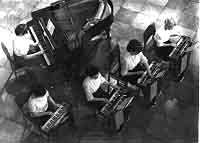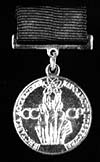
Ekvodin Synthesizer
by Andrei
Volodin
 Electronic
Musical Instrument EKVODIN was invented by Russian inventor Andrei Volodin (1914-1981) in late 30-s in
Moscow. It was the first analog electronic musical synthesizer, having: Electronic
Musical Instrument EKVODIN was invented by Russian inventor Andrei Volodin (1914-1981) in late 30-s in
Moscow. It was the first analog electronic musical synthesizer, having:
- dynamical keyboard after touch (keyboard, sensitive for pressure), possibility for playing with finger vibrato on the keyboard, like on the violin, two voices, 660 presets with excellent imitations of all acoustical musical instruments of the symphony
orchestra, including percussion, glide (portamento) control, built in slider, modulation controls foot pedals, special levers for knee control over the timber;
- synthesis, based on authors research in musical acoustics and psychoacoustics.
Since 30-s Andrei Volodin was participating in concerts and conferences in Russia, collaborating with other inventors, such as Konstantin Kovalsky, who was developing the new versions of the thereminvox and Evgeny Murzin (inventor of the ANS Synthesizer). At that time he was using the early home built instruments. First commercial instrument was built in middle 50-s. After that EKVODIN was awarded gold medals at the 1958 World Fair in Brussels and at the 1959 Exhibition of National Economy Achievements in Moscow.
Unfortunately, the success at the exhibitions was the only reason for Soviet government to support the project. The Soviet State was not interested in electronic music at all. They stopped funding the project in middle 60-s. Only a dozen of instruments were manufactured.
In 70-s Professor Volodin was teaching courses on musical acoustics and sound synthesis at Moscow State Conservatory, continuing his reasearch and developments of the Ecvodin synthesizer as well as new polyphonic instrument, which was not finished.
Advertising posters from 1960-s:
 EKVODIN EKVODIN
Musicians of the world are now provided with an exiting opportunity to refine their
emotional art. EKVODIN is an excellent instrument for any orchestra, ensemble or for solo
with piano accompaniment. The singing keyboard of small EKVODIN may fill every home with
fascinating melodies. Modern composers will be surprised to find EKVODIN produces
unprecedented clarity and variety of tones. Performers, conductors or teachers of music
will be satisfied with the great abilities of expression by EKVODIN.
EKVODIN opens cosmic horizons in music for everybody.
Technical data (Type «B-ll»):
- Keyboard range: 3.33 octaves (41 keys, by "C" to "e").
- Full sound range: 7.33 octaves.
- Accuracy of frequency is not worse them 3 cents.
- Tuning control for full range and for every key.
- Means for finger and automatic frequency vibrato and for glissando in full keyboard
range.
- Highest quality of sound.
- 660 combination of sound colour switching.
- Sustained and percussion sounds.
- Fine expression control.
- Music power output: 12 watts.
- Net: 110—235 volts 50—60 c.p.s.
- Weight: 39 kilograms.
- Dimensions: 0,78õ0,82õ0,38 metre.
Patents: Canada, England, French, German, Italian, USA.
Designed and manufactured in USSR.

The EKVODIN is a professional musical instrument intended for universal
use in various ensembles and orchestras and for solo performances including concerts with
the accompaniment of piano and other instruments.
The EKVODIN is suitable for different
musical genres.
The sound is produced in the EKVODIN on purely electrical principle.
The
instrument is noted for wide variety and brightness of timbres, broad range and high
limit) power of the sound, and also for rational and highly-developed system of
reproduction means (vibrating keyboard, loudness pedals, portamento, etc.). This ensures
expressiveness and accuracy of performance. The profession of a piano player is closest to
that of a man playing the EKVODIN. This similarity, however, does not determine the
application of the EKVODIN which is, first of all, an ensemble and orchestra instrument.
The EKVODIN comes in two design versions: one-voice and two-voice versions.
A thoroughly
developed system of timbres, varied with the aid of a special switch (and also depending
upon the methods of performance), makes it possible to obtain an expressive and pleasant
sound.
The EKVODIN imitates quite fully the sound of symphonic orchestra instruments (bow,
wood and brass groups, as well as certain percussion and pizzicato instruments) and also
folk instruments.
The EKVODIN allows to obtain sound personality in new timbres of modern
style. The instrument can be used in mixed ensembles and orchestras for supporting and
emphasizing different groups of solo parts performed on the usual (mostly string and
brass) instruments, when their natural power is not quite sufficient for overruling the
orchestra and for creation of new sounds. In incomplete orchestras and ensembles the
EKVODIN can handle practically any part (the two-voice will handle two parts) of the bow,
wood or brass groups.
 A special ensemble consisting of EKVODINS allows to obtain, for a
very small number of instruments (sextet or octet), a multifarious, fluent and high -
power sound in original and common timbres. Both design versions of the instrument come in
semi-stationary (dismountable-transportable) construction and high-class finish. The
extension loudspeaker unit, supplied with the instrument, can be located independently up
to a distance of 5 m. The loudspeaker unit is installed depending upon the location of
listeners. When carried or transported from place to place, the instrument is packed in
two units of suitcase type. For operation the instrument is connected to alternating
current mains (127 or 220 V). The EKVODIN is not sensitive to fluctuations of the mains
voltage. The one-voice version weighs about 35 kg, and its power consumption does not
exceed 90 VA. The output power of the sound channel reaches 10 \V. The two-voice version
weighs about 65 kg, and its power consumption does not exceed 200 VA. The output power is
up to 10 Win each channel, the timbre setting being independent for each voice. To double
the. power of solo parts and timbre effects the voices can merge in unison, octave and two
octaves. A special ensemble consisting of EKVODINS allows to obtain, for a
very small number of instruments (sextet or octet), a multifarious, fluent and high -
power sound in original and common timbres. Both design versions of the instrument come in
semi-stationary (dismountable-transportable) construction and high-class finish. The
extension loudspeaker unit, supplied with the instrument, can be located independently up
to a distance of 5 m. The loudspeaker unit is installed depending upon the location of
listeners. When carried or transported from place to place, the instrument is packed in
two units of suitcase type. For operation the instrument is connected to alternating
current mains (127 or 220 V). The EKVODIN is not sensitive to fluctuations of the mains
voltage. The one-voice version weighs about 35 kg, and its power consumption does not
exceed 90 VA. The output power of the sound channel reaches 10 \V. The two-voice version
weighs about 65 kg, and its power consumption does not exceed 200 VA. The output power is
up to 10 Win each channel, the timbre setting being independent for each voice. To double
the. power of solo parts and timbre effects the voices can merge in unison, octave and two
octaves.
 
The EKVODIN was awarded Gold Medals at the 1958 World Fair in Brussels
and at the 1959
Exhibition of National Economy Achievements in Moscow
The page was maintaned by A.Smirnov
10 November, 1997
|



